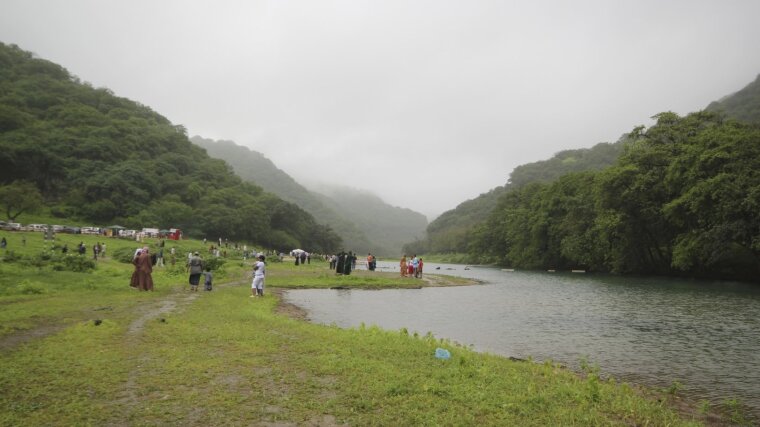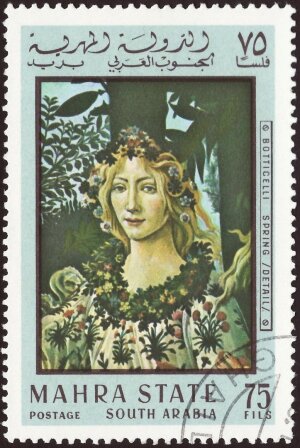
Stamp of the Mahra Sultanate of Qishn and Socotra (Mahra State, former Protectorate of Aden)
Foto: Postal administration of the Mahra Sultanate of Qishn and SocotraModern South Arabian languages are an endangered branch of the Semitic languages, characterized by many special features. Among them are:
- In the realm of phonology and phonetics: the ejectivity of the emphatic consonants, the lateral fricatives [ɬ] (also <ś>) and [ɬʼ] (also ṣ́ or ź), the interdental consonants [θ], [ð] and [θʼ], and the emphatic post-alveolar [∫ʼ]. In addition, consonant clusters are quite common. Omani Mehri is quite special among Modern South Arabian in usually not having a [ʕ] consonant.
- In the realm of morphology, Modern South Arabian languages are characterized by a tripartite verbal conjugation, including a perfect (suffix conjugation), a subjunctive (short prefix conjugation) and an imperfect (long prefix conjugation). The latter is absent from Central Semitic languages such as Arabic, Aramaic and Hebrew. They are also characterized by a rich dual morphology for all three persons and a prefixed (usually ħ-) definite article, which is mandatory before nouns with possessive suffixes.
Omani Mehri (or Dhofari Mehri) is the best described Mehri dialect. In the course, the students will be exposed to a preliminary grammatical survey of the language, and practice reading, glossing, analyzing and translating texts.
-
Course book
Watson, J. C. E. et al. 2020. Teghamk Åfyet: A course in Mehri of Dhofar. Wiesbaden: Harrassowitz.
-
Introductory literature
Rubin, A. D. 2010. A Brief Introduction to the Semitic Languages. Piscataway: Gorgias.
Johnstone, T. M. 1975. The Modern South Arabian Languages. Malibu: Undena.
Höfinger, S. 2018. Einige Beobachtungen zur Forschungsgeschichte der MSA-Sprachen. Wien: Studienarbeit.
-
Dictionaries
Johnstone, T. M. 1987. Mehri Lexicon. London: Routledge.
-
Grammars and Texts
Rubin, A. D. 2018. Omani Mehri: New Grammar and Texts. Leiden: Brill.
Watson, J. C. E. 2011. The Structure of Mehri. Wiesbaden: Harrassowitz.
Jahn, A. 1905. Grammatik der Mehri-Sprache in Südarabien. Wien: Hölder.
Bittner, M. 1909–1915 (2 vols.). Studien zur Laut- und Formenlehre der Mehri-Sprache in Südarabien. Wien: Hölder.
Wagner. E. 1953. Syntax der Mehri-Sprache unter Berücksichtigung auch der anderen neusüdarabischen Sprachen. Berlin: Akademie.
Stroomer, H. 1999. Mehri Texts from Oman. Wiesbaden: Harrassowitz.
-
Yemeni Mehri texts
Müller, D. H. 1902. Mehri- und Soqotri-Texte. Wien: Hölder.
Jahn, A. 1902. Mehri-Texte und Wörterbuch. Wien: Hölder.
Hein, W. 1909. Mehri- und Hadrami-Texte. Wien: Hölder.
Sima, 2009. Mehri-Texte aus der jemenitischen Šarqīyah. Wiesbaden: Harrassowitz.
-
Mehri culture and language
Watson, J. C. E. und A. M. Al-Mahri. In Quaderni di RiCOGNIZIONI 7 (2017), 87–103.
-
Sonstige Materialien
Sound files for the textbookExterner Link
You can download all the files after registering to the archive. Every file must be downloaded separately.
A glimpse into Yemeni Mehri culture (in Arabic)Externer Link

07743 Jena Google Maps – LageplanExterner Link
